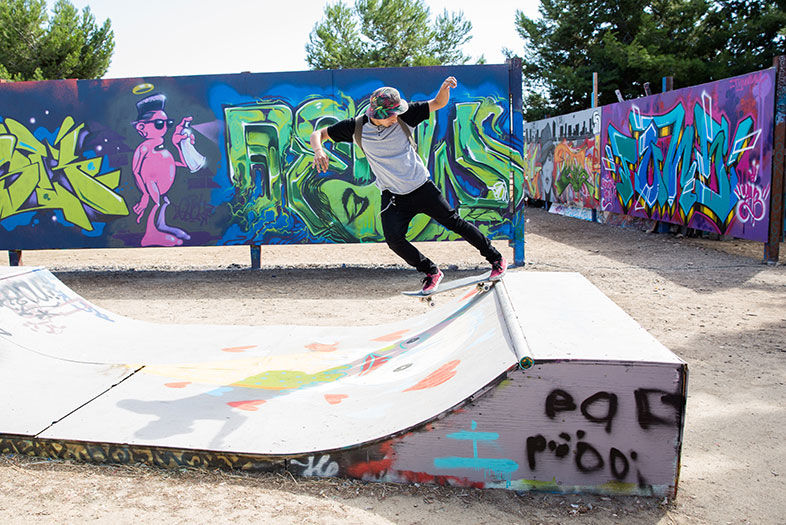San Diego’s Diamond
The Jacobs Center for Neighborhood Innovation is a public charity with a tight focus on the redevelopment and economic viability of Southeast San Diego’s Diamond neighborhoods, a name that references its diamond-shaped business improvement district.
10 neighborhoods make up the district. These neighborhoods fall within San Diego City Council District 4.
88,000 people live in the Diamond neighborhoods.
29.6 years is the median age of residents in the district.
60 acres is the amount of land owned by the Jacobs Center, the District’s largest landowner
53 percent of Diamond neighborhood residents are Latino, 21% are black, 13% are Asian, 9% are white, and 2% are Pacific Islander.
It’s said that art is transformative. In Southeast San Diego, it’s changing the landscape and lives of young people participating in Writerz Block, an urban arts program created by the Jacobs Center for Neighborhood Innovation.
With four new bungalows erected behind its Market Street graffiti yard, Writerz Blok began offering an “earn and learn” workforce training program in September 2016. The freshman class was handpicked by the local school district and San Diego police. This first group of 40 students, ages 14 to 24, were deemed “disconnected”: they come from low- and moderate-income households in a part of town known for its crime and gang activity, they’ve either dropped out of school or are at risk of dropping out, and they may have recently been in trouble with the law.
The new program aims to flip the script. Writerz Blok is using the neighborhood kids’ interest in music, skateboarding, and art to show them how they can use their abilities in real-life jobs. In a curriculum certified by San Diego State University and San Diego City College, they’re receiving training and mentoring in design-sector subjects including graphic design, screen printing, and media arts.
“We’re able to take that raw talent and turn it into a career,” says Writerz Blok’s finance manager, Sergio Gonzalez. “We use art to transform lives. It’s such a powerful tool.”
The new job training program formalizes the kind of anti-vandalism youth outreach Writerz Blok has done since its inception in 1999.
“We tell them, ‘Hey, there’s a space here where you can do something more with your artwork,” Gonzalez says.
After completing two weeks of unpaid personal development training and 10 weeks of creative and technical design instruction at minimum wage, students can take a four-week subsidized stint with one of Writerz Blok’s industry partners in fields including advertising and graphic design. Those companies could then offer them a long-term job.
The workforce training program has an annual budget of about a half million dollars, according to the Jacobs Center’s executive vice president, Angela Titus. That goes toward salaries, new buildings, specialized equipment, laptop computers, and software like Adobe Photoshop and Illustrator.
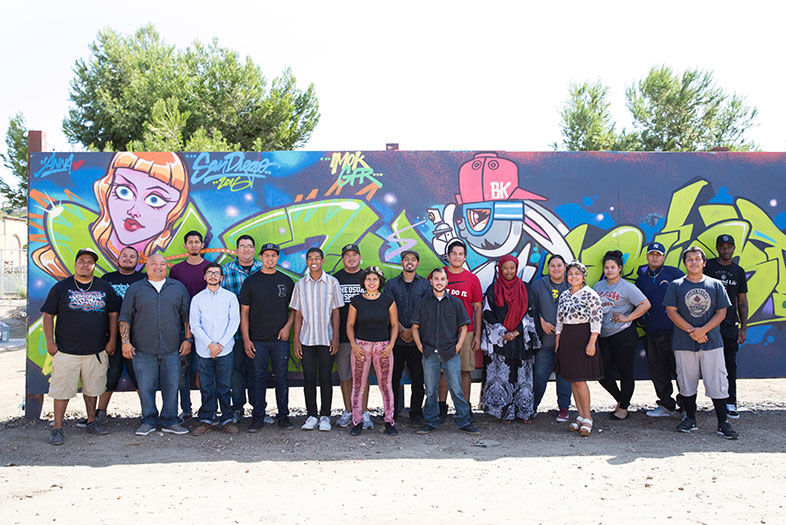
Taking Back the Block
Writerz Blok instructors and students at the graffiti yard on Market Street.
The Jacobs Center and Writerz Blok have had to get creative about how to raise operating and facility funds. Writerz Blok recently held an Indiegogo crowdfunding campaign for the bungalow classrooms and supplies. The Jacobs Center also recently secured a $211,991 “challenge grant” for Writerz Blok from the City of San Diego’s community development block grant (also known as CDBG) program. CDBG challenge grants are intended to serve highly vulnerable populations.
Titus says other funding for the workforce training program will need to come from private donations, corporate giving, and local and national grants.
Despite its tough, spray painted exterior, Writerz Blok has a way of charming its donors.
“People get it once they see it’s getting kids not to vandalize their community but instead to create career paths for themselves,” Titus says.
The Jacobs Center for Neighborhood Innovation was founded in 1995 by Joseph and Violet Jacobs as the charitable operating arm of the Jacobs Family Foundation. Joseph is perhaps better known for founding one of the world’s largest engineering companies, the publicly traded Jacobs Engineering Group. The Jacobs family decided they would redevelop Southeast San Diego’s gritty Diamond neighborhoods, drafting a master plan to buy and rehabilitate 60 acres of commercial, residential, and park space.
Gonzalez tells the story of how the Jacobs Center got an early initiation into Southeast San Diego’s street arts and culture scene. He was just a teenager when the Jacobs Center began its redevelopment there.
“They were unwelcome to us in our neighborhood,” he explains. “We thought it was going to be one of those things where they come in, build something, and leave.”
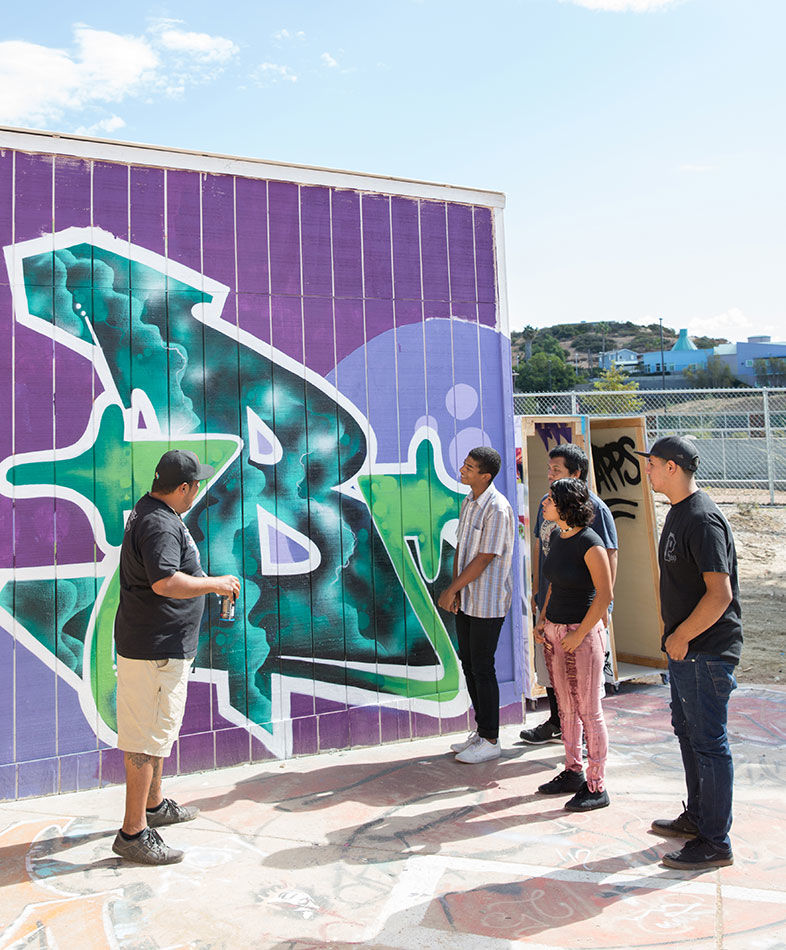
Taking Back the Block
Jose Venegas, production manager and instructor at writerz blok, uses a mural he created to explain spray painting techniques to a group of students.
The kids in the neighborhood expressed their disapproval with graffiti.
“When the Jacobs Center moved in here with all these construction trucks and trailers, to us, they were just blank canvases. We’d go out at night and we’d paint. And the next day they’d paint over us. And then the next night we’d go back and do it again. It became this cat-and-mouse game.”
Eventually the Jacobs Center sent representatives into the neighborhood to identify who was doing the tagging. But instead of filing charges with the police, the Jacobs Center did something surprising: It offered the kids soon-to-be- demolished walls to paint, and introduced them to accomplished muralists.
Originally known as Graff Creek for its proximity to Chollas Creek, the group of kids and artists met weekly at sites around the neighborhood. Eventually, the Jacobs Center offered them a half-acre piece of property near the city transit center at Euclid Avenue and Market Street. The property includes a run-down building—likely an old office for a bus mechanic—and some land with concrete slabs behind.
Writerz Blok has since turned the building into office and retail space, a darkroom, a screen-printing shop, and storage for hundreds of matte-finish, low-pressure aerosol cans of spray paint in every color imaginable. The yard has been filled with bungalows, skateboard ramps, and freestanding walls of graffiti art. It’s used as a neighborhood hangout and public art event venue.
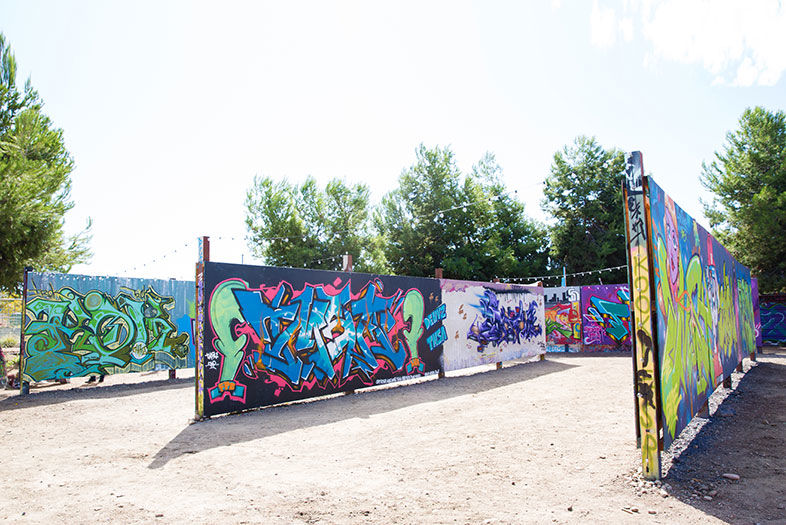
Taking Back the Block
Writerz Blok gives its students a safe place to create and express themselves through street art.
“If there’s no space to paint, where are you going to paint? Gutters, alleys, and freeways,” Gonzalez says. “This is heaven for a lot of people. People can come, take their time, showcase their talent, and are able to actually make it their career. They can build a portfolio and show people what they can do with spray paint.”
Gonzalez credits the Jacobs family with taking Writerz Blok from a social gathering to an entrepreneurial venture that can reduce area vandalism while giving job skills to kids who might not otherwise have a constructive outlet.
“They said, ‘How do we turn this into something productive and beautiful?’” says Gonzalez, who also acknowledges the Jacobs Center’s role in shifting his own trajectory from vandal to professional. “I got that opportunity to choose my life.”
In recent years, Writerz Blok has been commissioned to create temporary and permanent murals for San Diego museums and shopping centers, and to teach alternative arts education programs in schools from Jacumba to La Jolla.
Gonzalez says graffiti-style art has lost some of its social stigma, and is seen as a unique way to broaden the arts curriculum in public and private schools.
“They don’t see it as a nuisance and vandalism. They see it as a viable art form,” he says. “In the past few years, we’ve seen that shift of people seeing graffiti art as a collective art form. It’s being accepted more and more. You see it in museums, you see it on TV, you see it on cereal boxes. It’s gone mainstream.”
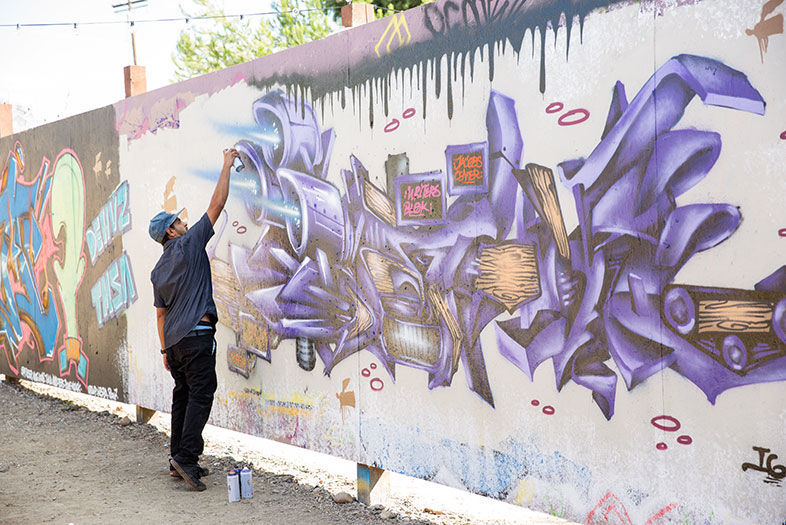
Taking Back the Block
Freelance artist Devon Gonzalez recently completed Writerz Blok’s boot camp.
Writerz Blok’s growth and evolution have made it an unconventional centerpiece for the Jacobs Center’s final neighborhood revitalization push before it sunsets within the next 15 years. The goal is to ready Writerz Blok to stand on its own and perhaps operate as a self-sustaining nonprofit.
The Jacobs Center also intends to designate a permanent facility for Writerz Blok, likely on some of its remaining acreage just a little farther down Market Street. Titus says it’s a matter of finding the right real estate partner to develop a mixed-use property that would make room for Writerz Blok’s offices, classrooms, graffiti walls, and event spaces.
“Writerz Blok is a really important part of bringing economic opportunity to this neighborhood,” she says.
Gonzalez envisions the new Writerz Blok as an urban arts academy with warehouse space, shipping containers repurposed as retail shops, and an open-air graffiti and skateboard park. The property could hold a collective of creative startups, from marketing and advertising firms to food truck businesses.
“Slowly but surely things are moving, things are happening. Everything is coming together so we can do what we do best,” Gonzalez says. “We’re the next thing to roll. It’s been a long time coming.”
Where Have I Seen This Before?
As the public increasingly appreciates graffiti as an urban art form, Writerz Blok’s work has gained regional acclaim. You might have seen their artwork around San Diego on:
Murals
The pool of Writerz Blok artists have been commissioned to create temporary and permanent pieces for clients including Qualcomm, The California Endowment, San Diego Museum of Art, San Diego Museum of Man, New Children’s Museum, Morse High School, The Old Globe, and Westfield Horton Plaza.
Clothing and Gift Merchandise
Writerz Blok has developed its own apparel line with T-shirts, hats, and giftware Including mugs and mousepads. custom skateboard decks are in the works.
Graphic Design and Printing
Writerz Blok teaches the youth of the Diamond neighborhoods how to provide print and graphic design services: business cards, posters and banners, and screen-printed shirts for area businesses.
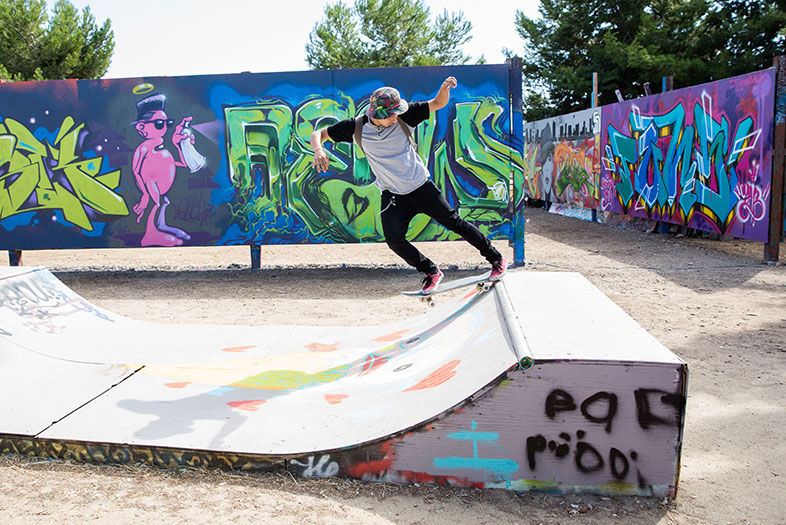
Taking Back the Block
PARTNER CONTENT
Jennifer Siegwart Rebecca Batista














